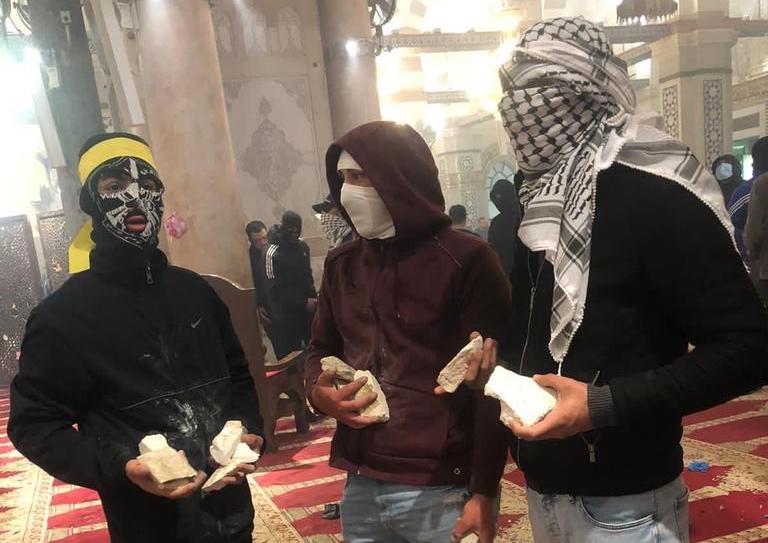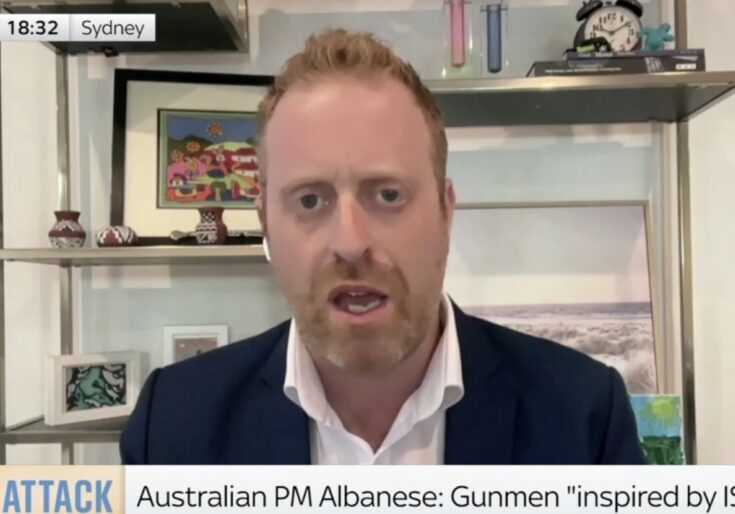FRESH AIR
‘Al-Aqsa in danger’: The libel fomenting the current Jerusalem violence
April 20, 2022 | Ahron Shapiro

April 18 saw the first rocket launched into Israel from Gaza in four months, as clashes between violent Palestinian gangs and Jerusalem police continued for a third day near the Al-Aqsa Mosque and along the Temple Mount in Jerusalem.
While the rocket was fired by Palestinian Islamic Jihad, Israel holds Hamas responsible for attacks launched from the Hamas-ruled Gaza Strip, and the Israeli Air Force struck Hamas targets in response to the rocket attack. Notably, Hamas reportedly fired a Russian-made Strela (SA-7) anti-aircraft missile, that missed its target, at the IAF planes.
This violence was fuelled by renewed false allegations, yet again, that Israel is endangering the Mosque, or planning to seize it from Muslim religious authorities.
Analysts say the confrontations in Jerusalem have been pre-planned by Palestinian groups and are being driven by antisemitic incitement and misinformation spread largely on social media.
The specific pretext claimed by Palestinians for the riots on the Temple Mount, which began on Friday morning, April 15, was an announcement by a handful of Jewish zealots that they would try to perform the sacrifice of a goat somewhere on the Temple Mount in observance of the Passover holiday. Biblical sacrifices were last done when the Second Temple stood over 2,000 years ago. Yet, Israeli police have never allowed such zealots to reenact Biblical sacrifices on the Temple Mount and this year was no different. On April 14, police emphatically vowed to uphold the status quo on the Temple Mount and arrested six extremists who were associated with such plans.
Nevertheless, Palestinian activists pursued confrontation anyway. Large stones were hurled down from the Temple Mount onto the Jewish prayer area at the Western Wall situated below. Israeli police acted swiftly, using crowd control measures and arresting more than 400 rioters – but soon releasing all but the organisers and most violent offenders.
In related violence, large rocks and cinderblocks were thrown through the windows of municipal buses passing through east Jerusalem, injuring passengers.
By acting swiftly, Israeli police aimed to allow peaceful Palestinians to continue to pray at the Al-Aqsa Mosque without hindrance, and 50,000 worshippers did just that later that day.
In commentary for Israel Hayom on April 17 titled “Al-Aqsa Mosque is by no means under threat”, Nadav Shragai, an expert on the friction between Moslems and Jews at the Temple Mount/Al-Aqsa Mosque area, wrote that reports that a handful of radical Jews hoped to carry out a Passover sacrifice of a goat on the Temple Mount provided a pretext for premeditated escalation by Hamas and the Palestinian Authority, planned to coincide with the always tense Muslim holy month of Ramadan. He noted that radical Jewish groups have made such claims before and Israeli security forces have always prevented such activists from obtaining access to the holy site.
For over a week now, Hamas and the Palestinian Authority have been telling the public online stories of how a ritual Passover sacrifice will be carried out on the Temple Mount.
They’re knowingly lying now, just as they did in the past. They know the Temple Mount’s history over the last 55 years. They know that Israel has never allowed it. Moreover, on a number of channels, including Jordanian, Egyptian, and American, the Palestinians, including the radical Muslims among them, have received clarification that this year, too, no such ritual will be allowed to take place. But Hamas and their ilk have knowingly chosen to ignore this and set the Temple Mount on fire because a large bonfire that once again sucks in Arab Israelis and pours oil onto the terrorism fire lit here in recent weeks suits them at this point in time.
Shragai further noted that Palestinians had moved stones and other weapons into the Al-Aqsa Mosque ahead of Friday’s clashes in preparation for rioting. (For more in-depth historical analysis by Shragai on the subject, see the section on additional reading at the end of this blog.)
The trope that Jews are threatening the Al-Aqsa Mosque, one of Islam’s major holy sites, has been used many times over the past century to promote violence, from the days of the notorious Grand Mufti Haj Amin al-Husseini in the 1920s and 1930s, to Palestinian leader Yasser Arafat in 1998 and 2000, and Sheikh Ra’ed Salah, the leader of the Northern Branch of the Islamic Movement in Israel today. In recent years, the allegation has been exploited most during the month-long Islamic festival of Ramadan, at a time when Muslim sensitivities are highest.
Also in Israel Hayom on April 18, journalist Dana Ben-Shimon offered a closer look at the Palestinian activists involved in violence on the Temple Mount and around Al-Aqsa Mosque, known as the Shabab al-Aqsa (“Youth of Al-Aqsa”). Ben-Shimon wrote that the Al-Aqsa issue has united a disparate cross-section of Palestinians to target Jews over this specific cause.
They aren’t members of an organized, hierarchical organization, nor are they necessarily devout Muslims. Each of them comes from a different background, and even their political affiliation, when one exists, is diverse…
What does stands out (sic) is their connection to social media. This is a generation that was brought up on the social media platforms of Facebook, Instagram, and TikTok, a realm where almost everything is allowed. They take care to post images and videos of arrests and document their friends attacking police, all to create as many victory images as possible online and raise morale.
Times of Israel editor David Horovitz noted that footage from inside Al-Aqsa Mosque during the rioting showed masked Palestinians armed with stones wearing shoes inside the Mosque – an act forbidden by Muslim law as a form of desecration in itself – evidence that the rioters had never really come to pray at all.
In a related piece of news, on Twitter, Jerusalem Post journalist Khaled Abu Toameh posted Arabic cartoons that had been spread over social media criticising Palestinians for desecrating the Al-Aqsa Mosque by kicking around a soccer ball inside the holy site.
Meanwhile, Yediot Ahronot columnist Ben-Dror Yemini wrote on April 17 that underpinning the recent terror wave and tensions on the Temple Mount are new generations of Palestinians being educated and indoctrinated with antisemitism, while their leaders, including the Palestinian Authority (PA) government itself, are preaching incitement against Jews:
[Palestinian leaders] do not fight for an independent state or for themselves, their fight is against Israel and their rhetoric is against Jews. Anyone who schools children in the hatred of Jews is the source of evil, and those who eliminate any mention of peace from textbooks is in search of something very sinister.
It’s not just Hamas and the Islamic Jihad who incite to violence. It is also the PA, that when forced to choose between building a national home on one hand, and antisemitic incitement on the other – they always prefer the latter.
Indeed, the NGO Palestinian Media Watch detailed religious incitement broadcast over the Palestinian Authority’s official television network on April 8 in the form of a prayer by an unnamed Imam.
“Allah, grant victory to the Jihad fighters in this land and the rest of the Muslim lands. Allah, strengthen them and grant them your support, O Mighty One… And take revenge on those who desire to harm Islam and the Muslims… Allah, have mercy on our Martyrs, heal our wounded, and release our prisoners, Allah liberate the Al-Aqsa Mosque from the defilement of the evil Jews.”
PMW notes, the nature of the prayer is particularly antisemitic, as Jewish visitors to the Temple Mount are never allowed to enter the Al-Aqsa Mosque itself.
For more background on the “Al-Aqsa is in danger” myth that has been used as a pretext for attacks against Jews in Jerusalem for over a century, see:
- Journalist Nadav Shragai’s 2012 comprehensive 161-page book “Al-Aksa Is in Danger” Libel: The History of a Lie” which is a landmark resource on the subject. It’s also available as a Kindle ebook. In 2020, Shragai revisited the same topic with a new book, Al-Aqsa Terrorism: From Libel to Blood” that has so far been published in full only in Hebrew. However, the Meir Amit Intelligence and Terrorism Information Center produced a comprehensive report “Al-Aqsa Terrorism: The Role of Religious Motivation in Popular Terrorism” based upon Shragai’s book, Israel Hayom published a large excerpt translated into English, the Jerusalem Post’s “In Jerusalem”editor Peggy Cidor interviewed Shragai about the book, while the press release that accompanied the book’s launch summarises many of the book’s key points.
- Israeli academic Shany Mor’s 2016 essay in Fathom “Debunking UNESCO’s Dangerous Anti-Semitic Myth That Israel Is Trying to Destroy the Al Aqsa Mosque”.
- Israeli academic Yisrael Medad’s May 2021 essay in Fathom, looking at “the remarks of the British politician Alfred Mond in 1921 which, though he subsequently clarified them, were purposefully distorted by the Arab leadership as a justification for violence for decades after.”
- Medad’s blogging of occasions when the ruse of a Jewish threat to the Al-Aqsa mosque has been used as justification for pogroms against the Jews of the land of Israel, going back many years before Israel’s creation.
Meanwhile, one side effect of recent events has been its consequences for Israeli politics.
The Islamist Ra’am party – an essential member of Israel’s unity Government – is walking a political tightrope between its constituents and its parliamentary responsibilities, and announced it would be suspending its membership in the coalition in response to the clashes. As the Knesset is on a holiday break, the move is seen as largely symbolic and appears to be a strategy to reduce community pressure on the party to quit the Government entirely over the Temple Mount issue.
Tags: Al-Aqsa, Israel, Jerusalem, Jewish, Palestinians, Temple Mount, Western Wall
RELATED ARTICLES

The Government’s actions still fall short: Joel Burnie on FDD Morning Brief

“The writing was on the wall for a number of years”: Colin Rubenstein on Channel 7 Weekend Sunrise





















